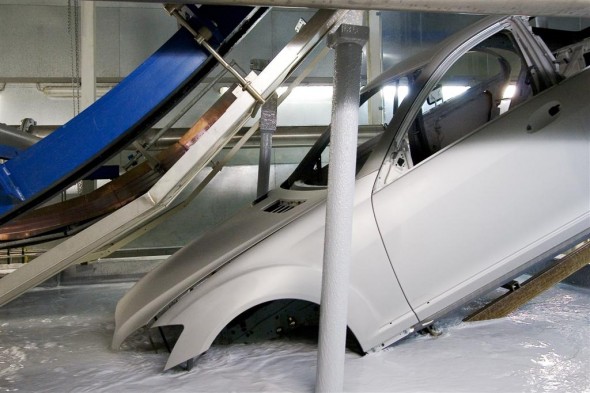Virtually painted

Simulation of painting processes optimizes production

Early planning cuts costs
Complex calculations reduce testing
The DaimlerChrysler researchers are developing special calculation methods to optimize painting processes. Even prior to production start-up, they can thus determine how a vehicle body can be painted as efficiently as possible or how an existing painting process can be improved. This early planning helps cut costs and enhances planning reliability.
No commercial program package is yet available on the market that can make predictions about painting processes. The DaimlerChrysler researchers are therefore using models to emulate the various systems and their dynamic processes. The findings from these simulations can be transferred to reality.
Toward practical application
With this tool, the production planners and developers can already test a newly designed vehicle body´s suitability for the painting process at an early stage. Complicated, expensive tests can be largely dispensed with, since the calculations provide reliable data. With their help, the planners are able to determine in advance the requirements for production and can design the processes accordingly. Modeling and numerical simulation are excellently suited for optimizing the existing infrastructure even in the ongoing production process. Paint robots, for example, can be adapted more rapidly and precisely to the task at hand.
Painting and spraying
The path of thousands of paint particles is traced by computer in the spray painting process from the time they leave the spray nozzle until they make contact with the component. The experts must take into account that not all particles actually reach their destination; the proportion of impacting particles is a measure of process efficiency.
The DaimlerChrysler researchers calculate the dynamics of the paint particles under the influence of the diverting air stream and the electric field applied, whereby the particles are subjected to a large number of physical forces. With the help of this simulation, the expected thickness of the paint layer can be forecast. The calculations also allow predictions as to the best procedure for applying the paint especially for problem areas such as cavities and protrusions on the body. The researchers can thus determine the ideal conditions for the most diverse vehicle geometries.
Impact and subsequent flow of the paint spray
While the spraying of paint particles is one challenge facing simulation, the mathematical description of the coherent paint film plays a no less important role. The composition of the paint, its cross-linkage and the pattern of its subsequent flow are closely interrelated. Material and heat transfer, together with the course of reactions, must be calculated for this purpose.
Dip baths
For the first coat of paint the body-in-white is not sprayed, but immersed in a bath. This method is known as cathodic dip painting. A wide range of effects must be taken into account for this process, such as air pockets during immersion or excess paint fluid removed with the body from the bath.
With their model calculations, the DaimlerChrysler researchers can predict the location and size of these air pockets and determine the volume of paint removed with the body. They also establish the mechanical loads on the body-in-white during the immersion process. From this data, they can calculate the forces and torques required by the body suspension mechanism.
Heating and drying
The body is heated for some minutes in drying units at up to 180 Celsius, depending on the step of the process. Here, the scientists must forecast reliable temperature distribution patterns and the behavior of the entire body during heating.
The transfer of heat by convection and radiation is simulated on the basis of prevailing flow patterns and temperature distribution in the dryer. The transfer of heat to the body and conduction of heat within it must also be taken into account. Side-effects are loss through solvent evaporation from the paint film and thermal distortions on the body-in-white.
In the case of paint drying, for instance, the production planners can acquire information on required drying times without having to carry out tests beforehand. With their model calculations, the researchers are making a significant contribution to cost-efficient painting processes and high paint quality.





